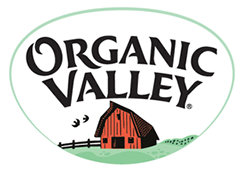

Share your finished recipe with #OVRECIPES

Recipe by Carly Knowles, MS, RDN, LD
Carly Knowles, MS, RDN, LD is a masters-educated Registered Dietitian Nutritionist and Certified Doula. Combining her expertise in nutrition with her love and passion for cooking, Carly helps moms nourish themselves and their families with seasonal whole foods.
Homemade Yogurt (Instant Pot and Stovetop Methods)
Yogurt is an incredibly nutritious food, especially when it’s organic and made from 100% grass-fed cow’s milk. Thanks to these straightforward methods, homemade yogurt with seasonal fruit will become a healthy breakfast staple or easy snack you’ll always have on hand. You can use whole milk if you like it creamy and rich or fat-free for a lighter version.
5 MIN PREP
480+ MIN COOK
485+ MIN TOTAL
8 servings
Ingredients

⅓ cup yogurt starter (whole or fat-free yogurt, must contain “active cultures” or “live cultures” in the ingredient list)

Sliced almonds


Fresh strawberries, sliced


Fresh cherries, pitted and chopped


Honey or maple syrup

Directions
Using an Instant Pot or Multi-cooker, clean the inner pot and lid with hot soapy water and dry thoroughly—do not skip this step. It’s very important that every tool used in making yogurt is sparkling clean. Return the inner pot to the base and add the milk. Lock the lid into place and press the “yogurt” button or “pasteurize” setting and then “start” (check your device’s instruction manual for the location of these settings, if needed). This will bring the milk to just below a boil, 180 degrees F to 200 degrees F. This is a necessary step to ensure the end product sets and doesn’t separate and release liquid.
Next, remove the lid and let the milk cool to 110 degrees F to 115 degrees F, about 1 hour (monitor with a candy or instant-read thermometer). You can speed up the process by placing the inner pot into an ice bath, if desired.
Once at the desired temperature, remove and discard any skin that may have formed on top of the milk (common when using whole milk). Remove 1/2 to 1 cup of warm milk and place it in a small mixing bowl. Add the yogurt starter and whisk until smooth. Add the milk-yogurt mixture back to the inner pot, give it a stir, and then lock the lid into place.
Press the “yogurt” button again and turn it to the “ferment” setting, or set the temperature to 110 degrees F and adjust the time to a minimum of 8 hours up to 24 hours. The longer you ferment the yogurt, the firmer and tangier it will become. You can stop and taste along the way, adjusting the timing as needed (I prefer to ferment my yogurt for 8 to 12 hours). If using fat-free milk, you may want more time to get a firmer texture.
Once the fermentation is complete and your yogurt has set to your desired consistency and taste, remove the inner pot from the base and transfer the yogurt to a tub or individual containers (a canning funnel is handy if using individual containers). If using fat-free milk, some liquid may have formed on top of the set yogurt; gently pour this liquid off before refrigerating. Refrigerate the yogurt for at least 8 hours or overnight for optimal texture and temperature before serving.
Using your stovetop, clean a Dutch oven or heavy saucepan with hot soapy water and dry thoroughly—do not skip this step. It’s very important that every tool used in making yogurt is sparkling clean.. Add the milk to the pot and place over medium-high heat. Using a digital thermometer, heat the milk to just below a boil, 180 degrees F to 200 degrees F. This is a necessary step to ensure the end product sets and doesn’t separate and release liquid.
Remove the pot from the heat and let the milk cool to 110 degrees F to 115 degrees F, about 1 hour (monitor with a candy or instant-read thermometer). You can speed up this process by placing the pot into an ice bath, if desired.
Once it reaches the desired temperature, remove and discard any skin that may have formed on top of the milk (common when using whole milk). Next, remove 1/2 to 1 cup of warm milk and place it in a small mixing bowl. Add the yogurt starter and whisk until smooth. Add the milk-yogurt mixture back to the pot and stir.
Place the lid on the pot and transfer yogurt to an unheated oven. Turn the oven light on. The heat from the oven light is enough to ferment and set the yogurt. Let the yogurt sit untouched for 8 to 24 hours. The longer you ferment the yogurt in the oven, the firmer and tangier it will become. (I prefer to ferment my yogurt for 8 to 12 hours.) If using fat-free milk, you may want more time to get a firmer texture.
Once the fermentation is complete and your yogurt has set to your desired consistency, remove pot from the oven and transfer the yogurt to a tub or individual containers (a canning funnel is handy if using individual containers). If using fat-free milk, some liquid may have formed on top of the set yogurt; gently pour this liquid off before refrigerating. Refrigerate the yogurt for at least 8 hours or overnight for optimal texture and temperature before serving.
To serve: Enjoy your homemade yogurt with a spoonful of cherry compote (recipe linked below) and a sprinkle of sliced almonds, or some strawberry rhubarb sauce (recipe linked below) for some fruity and wholesome fun! Fresh strawberries or cherries drizzled with a little honey or maple syrup make great toppings too.
Homemade yogurt will keep in the refrigerator for 10 to 14 days. When you’re ready to make your next batch, reserve 1/3 cup from the previous batch to use as the yogurt starter for the next batch.
© Organic Valley 2024. All rights reserved.














